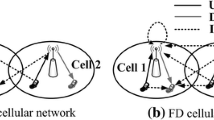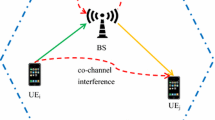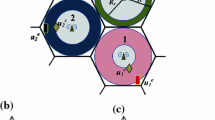Abstract
In-band full-duplex (FD) communication has been considered as a promising technology to enhance the spectral efficiency (SE) for the next generation of wireless system. However, the severe interference in FD cellular network may largely degrade the system performance, especially for cell edge users. In this paper, multi-cell cellular network consisting of BSs with FD capability and legacy half duplex (HD) users is studied. In order to relieve the received interference and enhance the system SE, a new resource allocation strategy named fractional FD (FFD) is proposed and its main idea and procedure are described as follows. Firstly, the frequency and time resources are partitioned into FD resource blocks (RBs) and HD RBs based on the network topology. Then all the users are classified into two groups named cell center users (CCUs) and cell edge users (CEUs) based on their channel conditions. At last, in each cell, each FD RB is allocated to a pair of CCUs with one in uplink and the other in downlink transmission direction, while only one CEU in the uplink (or downlink) transmission direction is scheduled over each HD RB. Tractable results of both the coverage probabilities and the ergodic rates of FFD, FD and HD systems are derived using stochastic geometry method. Numerical results show that, FFD can significantly improve the coverage probability of all users especially for CEUs compared with FD cellular system, and higher system SE is obtained compared with FD and HD cellular network. With proper design of the classification criterion and under the simulation settings of this paper, the SE of FFD system outperforms FD and HD system by 1.25 and 1.38 times, respectively.
Similar content being viewed by others
References
Sabharwal A, Schniter P, Guo D, et al. In-band full-duplex wireless: challenges and opportunities. IEEE J Sel Area Commun, 2014, 32: 1637–1652
Kim D, Lee H, Hong D. A survey of in-band full-duplex transmission: from the perspective of phy and mac layers. IEEE Commun Surv Tut, 2015, 17: 2017–2046
Bharadia D, McMilin E, Katti S. Full duplex radios. SIGCOMM Comput Commun Rev, 2013, 43: 375–386
Duarte M, Dick C, Sabharwal A. Experiment-driven characterization of full-duplex wireless systems. IEEE Trans Wirel Commun, 2012, 11: 4296–4307
Goyal S, Liu P, Panwar S, et al. Full duplex cellular systems: will doubling interference prevent doubling capacity? IEEE Commun Mag, 2015, 53: 121–127
Liao Y, Song L, Han Z, et al. Full duplex cognitive radio: a new design paradigm for enhancing spectrum usage. IEEE Commun Mag, 2015, 53: 138–145
Liu G, Yu F, Ji H, et al. In-band full-duplex relaying: a survey, research issues and challenges. IEEE Commun Surv Tut, 2015, 17: 500–524
Riihonen T, Werner S, Wichman R. Hybrid full-duplex/half-duplex relaying with transmit power adaptation. IEEE Trans Wirel Commun, 2011, 10: 3074–3085
Ahmed E, Eltawil A, Sabharwal A. Rate gain region and design tradeoffs for full-duplex wireless communications. IEEE Trans Wirel Commun, 2013, 12: 3556–3565
Chai X, Liu T, Xing C, et al. Throughput improvement in cellular networks via full-duplex based device-to-device communications. IEEE Access, 2015, 4: 7645–7657
Shao S, Liu D, Deng K, et al. Analysis of carrier utilization in full-duplex cellular networks by dividing the co-channel interference region. IEEE Commun Lett, 2014, 18: 1043–1046
Bai J, Sabharwal A. Distributed full-duplex via wireless side-channels: bounds and protocols. IEEE Trans Wirel Commun, 2013, 12: 4162–4173
Nguyen D, Tran L, Pirinen P, et al. Precoding for full duplex multiuser mimo systems: spectral and energy efficiency maximization. IEEE Trans Signal Process, 2013, 61: 4038–4050
Nguyen D, Tran L, Pirinen P, et al. On the spectral efficiency of full-duplex small cell wireless systems. IEEE Trans Wirel Commun, 2014, 13: 4896–4910
Boudreau G, Panicker J, Guo N, et al. Interference coordination and cancellation for 4G networks. IEEE Commun Mag, 2009, 47: 74–81
Shen Z, Khoryaev A, Eriksson E, et al. Dynamic uplink-downlink configuration and interference management in TD-LTE. IEEE Commun Mag, 2012, 50: 51–59
Lee J, Quek T. Hybrid full-/half-duplex system analysis in heterogeneous wireless networks. IEEE Trans Wirel Commun, 2015, 14: 2883–2895
AlAmmouri A, ElSawy H, Amin O, et al. In-band duplex scheme for cellular networks: a stochastic geometry approach. IEEE Trans Wirel Commun, 2016, 15: 6797–6812
Thomsen H, Popovski P, Carvalho E, et al. Compflex: comp for in-band wireless full duplex. IEEE Wirel Commun Lett, 2016, 5: 144–147
Li Y, Fan P Z, Leukhin A, et al. On the spectral and energy efficiency of full-duplex small cell wireless systems with massive MIMO. IEEE Trans Veh Tech, 2017, 66: 2339–2353
Andrews J, Baccelli F, Ganti R. A tractable approach to coverage and rate in cellular networks. IEEE Trans Commun, 2011, 59: 3122–3134
Simeone O, Erkip E, Shamai S. Full-duplex cloud radio access networks: an information-theoretic viewpoint. IEEE Wirel Commun Lett, 2014, 3: 413–416
Sato H. The capacity of the gaussian interference channel under strong interference. IEEE Trans Inf Theory, 1982, 27: 786–788
Novlan T, Dhillon H, Andrews J. Analytical modeling of uplink cellular networks. IEEE Trans Wirel Commun, 2013, 12: 2669–2679
Access E U T R. Further advancements for E-UTRA physical layer aspects. 3GPP Technical Specificatio TR, 2010, 36: V2
Acknowledgements
This work was supported by National Basic Research Program of China (Grant No. 2012CB316002), National Natural Science Foundation of China (Grant No. 61631013), National High Technology Research and Development Program of China (863 Program) (Grant No. 2015AA01A706), National Natural Science Foundation of China (Grant No. 61321061), Tsinghua University Initiative Scientific Research Program (Grant No. 2015Z02-3), National S&T Major Project (Grant No. 2014ZX03001011), Key Project of International Science and Technology Innovation Cooperation Between the Government (Grant No. 2016YFE0122900), and Huawei Technologies.
Author information
Authors and Affiliations
Corresponding author
Rights and permissions
About this article
Cite this article
Bi, W., Xiao, L., Su, X. et al. Fractional full duplex cellular network: a stochastic geometry approach. Sci. China Inf. Sci. 61, 022302 (2018). https://doi.org/10.1007/s11432-016-9042-8
Received:
Revised:
Accepted:
Published:
DOI: https://doi.org/10.1007/s11432-016-9042-8




